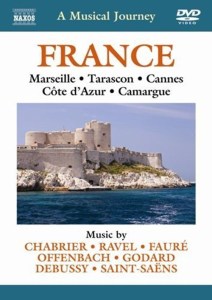 |
 |
|

Support
us financially by purchasing this disc from: |
|
|
|
|
|
A Musical Journey: France - A Musical Tour of
Provence
Chapter 1: Chateau du Roi René, Tarascon
Chapter 2: Chateau d’If, Marseille
Chapter 3: Camargue Landscape
Chapter 4: Port de Poussai
Chapter 5: St-Raphaêl, Ile d'Or, Cote d'Azur
Chapter 6: La fête des gardiens, Arles
Chapter 7: Port Camargue
Chapter 8: Corniche de l’Esterel, Cannes
Chapter 9: Nautilus Aquarium, Cannes
Chapter 10: Fréjus
Chapter 11: Aigues-Mortes, Camargue
Music by Emmanuel Chabrier, Maurice Ravel, Gabriel Fauré,
Godard, Claude Debussy, Jacques Offenbach and Camille Saint Saëns
Music from Naxos CD 8.570057 French Festival. Slovak Radio
Symphony Orchestra/Keith Clark and Ondrej Lenárd
No recording dates or venues given
DVD Director: G. Gachot
Cameraman: H T Aschwanden
Audio Format: DTS 5.1. Dolby Digital 5.1. PCM Stereo 2.0
Video Format: NTSC. Region 0. Colour. Aspect ratio 4:3
 NAXOS 2.110312
NAXOS 2.110312  [55.09]
[55.09]
|
|
|
The main content of the photography in this issue focuses on
the area east of the Rhone and south of Nimes. This is the Provence
region. It is famous for its scenery, seaside resorts for the
chic and its memorable Corniche drive. That’s before we
get to the traditions of the Camargue, the region where the
Rhone splits into a wide marshy area before pouring into the
Mediterranean Sea. Look at the booklet and this is what you
expect to see.
However, I have become used to the frustrations as well as the
enjoyments of reviewing these Musical Journeys on Naxos.
No grumbles about the musical performances. As here, they are
never less than good and often much better than that. My frustrations
arise because of the choice and focus of the photography. It
often lingers excessively on wind-blown fields of grass, or
a sunset, when I know there are wonderful sites that could be
shown a mere stone’s throw away. My frustrations with
this issue are that the descriptions of the contents too often
do not match what is seen. The booklet mentions (CH.8) the Corniche
de l’Esterel and that it was built in 1903 along the
coastal side of the Massif of the same name. It is a magnificent
drive from St-Raphaêl to Cannes that is also mentioned
as being famous for its film festival. Mention, but do not show,
seems to be the policy. Yes we see some of the captivating inhabitants
of the Nautilus Aquarium at Cannes and waters lapping St-Raphaêl,
but pretty well everything else between is viewed from a boat
including the inside of a cave! Believe me, it is nothing like
as spectacular as the drive along the Corniche, one that has
featured in several films. It’s the same with Fréjus
(CH.10): we see nothing of the town whilst Port de Poussi (CH.4)
is a waste of picture time.
That is the bad news out of the way. As well as some well-played
and evocative music there are some good parts. The start (CH.1)
at the mighty bastide castle of Tarascon, the Chateau of King
René at a time before a unified France came into being
and situated adjacent to the Rhone, is well photographed, both
near to and from across the river. Its preservation makes it
one of the finest medieval castles in France. Regrettably we
do not see much of its inner architecture. It would have been
interesting to have photographs of the view from its ramparts
across the river to the west side where stands the castle of
Beaucaire, formerly a stronghold of the Counts of Toulouse.
Satisfying also are the views of the bleak round tower of the
Chateau d’If, and of the port of Marseille, the largest
in the Med. Built between 1524 and 1528 on a nearby island the
Chateau d’If was designed to protect the port. It was
later used as a prison and immortalised by Alexandre Dumas who
imprisoned two of his heroes here, The Man in the Iron Mask
and The Count of Monte Cristo. It was used as a prison
and it is interesting to see the internal architecture.
The filming does cross the Rhone to the west to visit the town
of Aigues-Mortes (CH.11). This fortified town was built for
Louis IX for use by his huge armada of ships, hired from Venice,
to embark on a crusade to Cyprus in 1248. It now stands four
miles from the sea, connected to it by a canal and to the north
by the Canal du Rhone. The ramparts are extensive and encompass
the whole town which is remarkably preserved, seemingly unscathed
by the ravages of time. Look carefully at one point and you
will see the saltpans that now provide a major source of income.
There are views of the Camargue and the white horses as have
been seen on other issues in this series (CH.3). Also included,
and more interesting, is the La fête des gardiens
(CH.6). This is the annual celebration of the custodians of
the Camargue in all their finery astride the white horses; the
men traditionally saddled, the women side-saddled. Briefly on
show at this celebration is the Roman Arena at Arles of which
more could gainfully have been shown. The music of Offenbach
is appropriate here as is his Barcarolle from the Tales of
Hoffmann in the visit to the Nautilus Aquarium.
Robert J Farr
Support
us financially by purchasing this disc from: |
|
|
|
|
|
|

